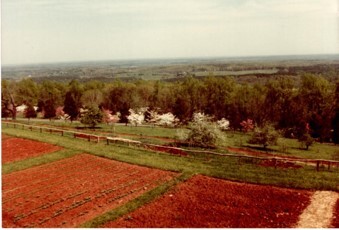The Promise of a Garden

No occupation is so delightful to me as the culture of the earth, and no culture comparable to that of the garden.
Thomas Jefferson
Well, the last Christmas cookie has been crunched, the last pine needle swept up and the last metal ornament hanger placed in the junk drawer as we bid farewell to another Christmas holiday season.
So, of course, it’s that time.
No, not time for Valentines Day candy, although that’s close.
This is the time of year to plan your garden. However, true, avid gardeners would argue that planning a garden is a full-time project. A never-ending cycle of preparation and designing.
But for me, this is when seed and gardening catalogues and some spring magazines arrive in the mail. A time to cozy up with a cup of tea and peruse my treasure trove of Spring promise. Time to slowly leaf through the wonderous pages of lush azaleas, colorful tulips and fragrant stargazer lilies.
Dreamily gazing out my window at the wintry landscape, I can envision all those glorious colors coming to life in my yard with the arrival of the first robin.
For the gardening untutored, (that would be me) I learned about planting in varying degrees. My mom taught me some things about planting. I read other tidbits in catalogues and magazines, and the good old, trusty hard way. One of my plants would thrive while two others failed. And I learned, over time, that just like words, soil matters. So does climate. A lot.
Recently I read a very interesting article about Thomas Jefferson and his garden at Monticello. Many years ago, I visited Monticello, but was overwhelmed by all the beauty and history at that time. Except for one tree that intrigued me, I just gave nodding acquaintance to Jefferson’s gardens. Since it was early Spring there wasn’t too much growing yet.
But the article (discovered in an old Southern Living Magazine, Breaking Ground by Steve Bender September 2012), tells of his experiments and failures with various fruits and vegetables. Those failures only spurred him on to more experiments. Soil, climate, type of beds, what seeds would thrive where. He grew plants from around the world. Foreign embassies would provide the seeds and Jefferson, in turn would give them to local farmers. He also traded seeds with friends and neighbors.
One interesting side note in the article, explains how the Monticello family physician made a red pepper gargle from Jefferson’s gardens for his grandchildren for their sore throats. So back in the 1800’s, they were learning about the use of capsaicin as a pain reliever.
Jefferson was a statesman, lawyer, diplomat, architect and philosopher. And a serious gardener. He is known to have recorded 330 varieties of seventy species of vegetables grown at Monticello. Plotting, planning, recording, and charting, Jefferson’s experiments and research had an enormous impact on the food we grow today.
We can thank “America’s First Foodie” as he was called according to the article, for tomatoes and peppers, eggplant and squash and so many other vegetables from around the world.
So, when Spring finally comes, and you turn over the soil in your garden, think of the bounty to come and then thank Thomas Jefferson.
Happy gardening!



